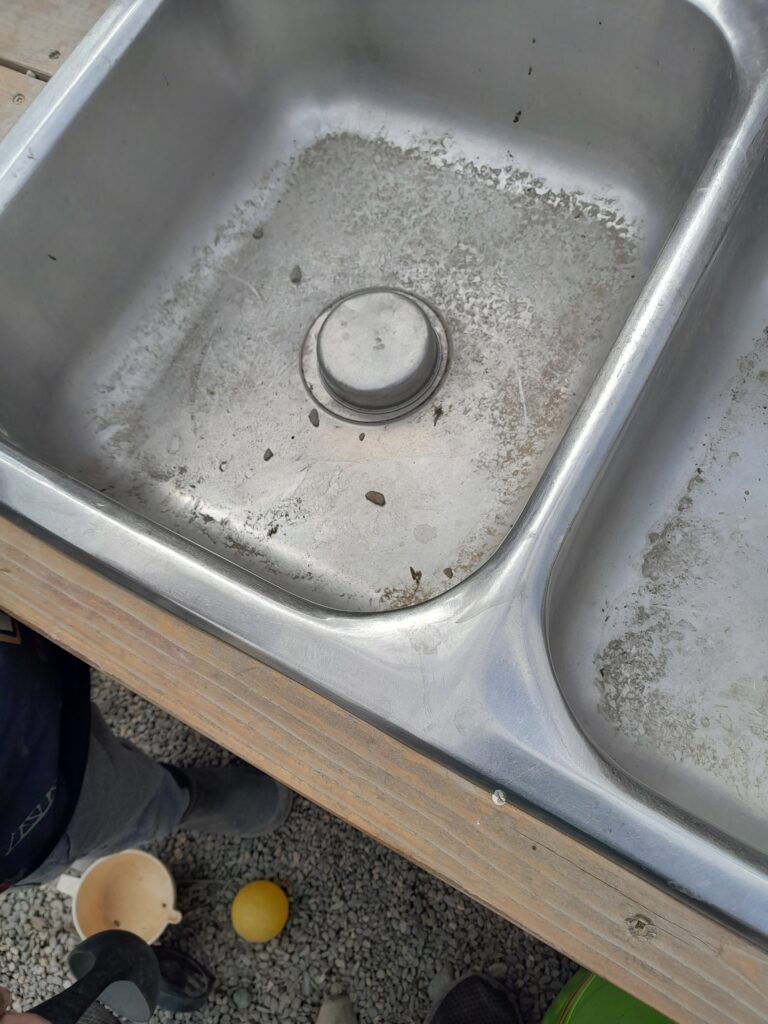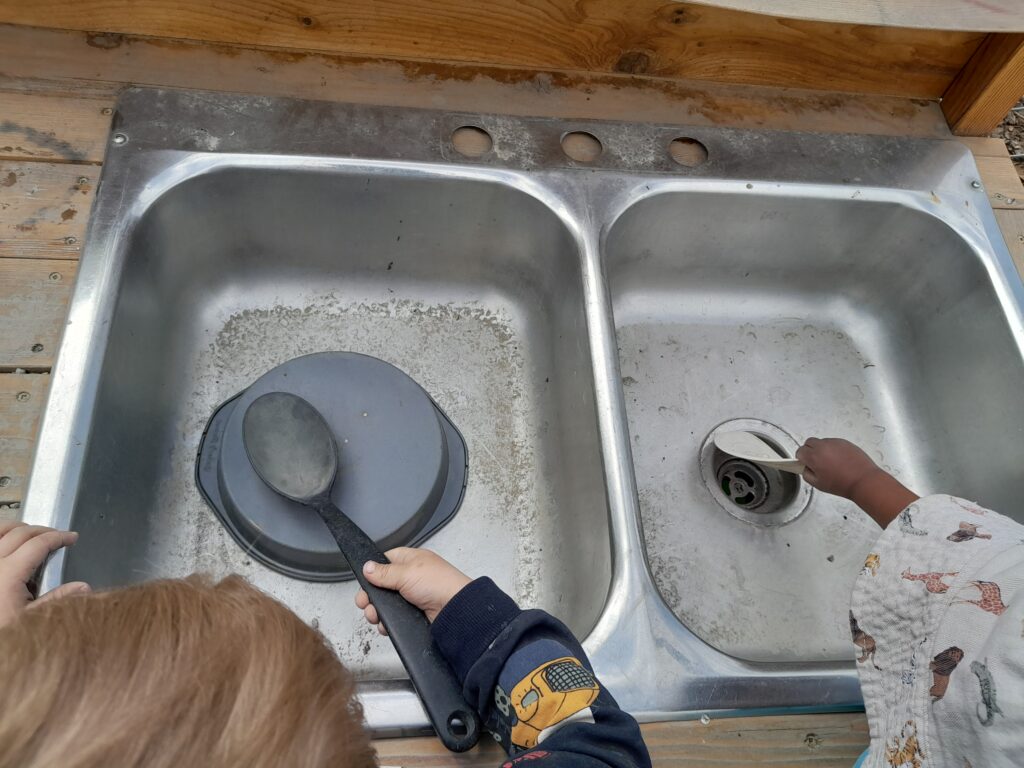Reflection 1: April 29, 2024
Educators are Researchers and Collaborators (BCELF)
Educators work with children and families as researchers, keeping an open mind to the unexpected. They are increasingly more partners and researchers who set up the environment for children to explore ideas, develop theories, and learn independently rather than just imparting knowledge. In addition, educators encourage children’s curiosity, which enables them to enhance their learning. Educators constantly watch, listen, and experiment while remaining receptive to diversity and various perspectives.
Educators partner in research along with children and families. They are collaborators who create conditions so that children can invent, build theories, and learn (BC ELF, 2019, p.18). As I observed through the practicum, I have seen clear examples of how educators collaborated with children in building their theories. One of the educators was playing along with the children in the yard on the choo-choo train and they were running up and down the hill making choo-choo noises and pretending to be on a train. The children and educator seemed to be enjoying the play as they dialogued what was happening between them. Through the choo-choo train play they were unintentionally discovering who they were and exploring the train itself.
The dialogues like Choo-choo Train down in the station
What do we need for Energy?
Choc Chip Cookies, we now have energy and back to the top of the hill.
This is a clear example of how the educator collaborates with children and helps them invent themselves through collaborative dialogues and by playing with them.
I also had an opportunity to notice another instance where the educator and children had a dialogue over a bus that was trying to enter the warehouse. The collaborative dialogue included things like: I think the bus trying to go in that warehouse, It is going into that building, Why do you think they are going inside? Maybe taking rest? Maybe broken? Maybe missing a wheel? etc. Time to watch and wonder what the bus was doing help them to think about that situation and come up with possible scenarios.
The conditions created by the educator as well as the dialogues, observations, play, etc. helps children and educators investigate and build theories thus seeking ways to extend their learning. It also helps them to build reciprocal relationships.
Karolyn’s notes April 30, 2024
Thanks Resmi, you have already made some great connections here. I can see that you are considering the idea of educators as collaborative learners and co researchers with children. You have included quotes from the ELF and connect them with examples/observations from your practicum experience.
I have made some grammatical edits for example your in text citation and some of your sentence structure. You can review and let me know if you have any questions.
Don’t forget to date your entries.
Reflection 2:
For this week I encourage you to review the documentation and folder of related articles for their exploration with the tree, poppies is already engaging in. This is a great example of educators thinking pedagogically and deciding what to do/explore etc. The teacher directed part of this exploration is:
-deciding to ask a question about how educators can deepen children’s thinking (See the wall for actual question),
-choosing to visit and revisit the tree as way to explore the question,
-what they will choose to focus on as each experience unfolds, etc.
The children’s role is to take up these “offerings” (going for a walk to the tree, open questions, etc.) and engage with them in ways that meaningful to them, (to point, talk, look closely, notice, listen, explore etc.)
Using the same process I would like you to review the documentation and at least one of the articles in the file folder and
-summarize them in your own words
-look for connections you see and experience in the program as you interact with children, educators and experiences. Don’t forget to add photos, and other traces to your reflective work to help bring it to life.
May 5th, 2024
The article is about “Sportscasting,” sportscasters don’t criticize, fix, shame, or place blame; instead, they keep children safe, observe and report what they see, and let children figure out how to address problems on their own or move on to something else. One of the many advantages of sportscasting is that children think and learn more when we do less. When children struggle with a problem, we can let them work things out on their own. If they need additional assistance, we can offer recommendations or pose open-ended questions. By taking turns, deciding to move something else, or engaging in activities together, the children are better able to resolve conflicts. Children therefore will learn much more and gain confidence when the educators control their urge to solve problems. Another advantage of sportscasting is that it fosters our children’s trust and belief. When we let things unfold naturally, it promotes confidence and reliance rather than unnecessary dependence. Sportscasting serves as a helpful reminder to not pass judgment on children, which can damage a child’s learning and self-esteem and educators’ ability to connect with them and accept things as they are. Children are also encouraged not to identify as attackers or victims. Children become victims or aggressors when we overprotect, shame, or take sides. Victims think they are helpless and weak, while aggressors think they are cruel and nasty. Sportscasting allows us to facilitate experimental learning, which is the most effective, meaningful, and profound learning method possible. It also helps youngsters understand situations clearly and develop their emotional intelligence. Sportscasting is not recommended when there are any safety issues or disruptive or destructive patterns of behaviour.
As I observed during my practicum, I have a situation where I am also involved, enabling me to do sportscasting since a child needs assistance solving an issue. I got to spend some time in the yard with a child named Finn as part of building relationships with children. There were two miniature kitchen sinks in the yard at the centre, and one of them was missing its stopper. The child was a little disappointed when he realized that one of the washbasins didn’t have a stopper because he had wanted to play with it. Rather than assisting him in locating the lost one, I ultimately chose to watch and let him figure out a solution through collaborative dialogues. To my amazement, he came up with several choices and was also quite aware of the dimensions that he needed to fit the washbasin.
The children fighting over toys was one of the other instances I frequently saw at the practicum location, and most of the time the educator’s let children figure out their problems by telling them Did you notice another ball there? Ask them what they do in the situation or, patiently acknowledge their feelings etc.
Karolyn’s Notes May 6
It is great to hear that you are interacting with children and allowing them space to work on problems and create their own solutions when possible. I wonder how the two examples you mentioned above relate to “sportscasting”?
What connections can you make to the BC Early Learning Framework regarding ?
What skills can you work on to practice sportscasting and experience this learning in action?
May 12th, 2024
BC ELF principle 1 states that Children are strong, capable in their uniqueness, and full of potential. This idea holds that each child is a gift, capable of being unique, and capable of reaching their greatest potential while developing interdependence with others and their surroundings. Children can fully develop when they have a reciprocal interaction with others, things, and their surroundings. The childhood also depends on how the adults engage with children. By using sportscasting, we can make sure that children are resilient and full of potential and that they should be allowed to solve difficulties on their own or go on to something else rather than being corrected, criticized, fixed, ashamed, or placed blame. By doing less, we can help children think and learn more, which will help them reach their greatest potential.
BC ELF Principle states Educators are researchers and collaborators. Educators partner in research along with children and families they are also collaborators who create conditions so that children can invent, build theories, and learn. The role of educators is partners and researchers who set up the environment for children to explore ideas, develop theories, and learn independently rather than just imparting knowledge. Educators constantly watch, listen, and experiment while remaining receptive to diversity and various perspectives. Educators work in relationships with children and ensure children feel safe, confident, motivated, and listened to. Sportscasting allows us to facilitate experimental learning, which is the most effective, meaningful, and profound learning method possible. It also helps youngsters understand situations clearly and develop their emotional intelligence. it promotes children’s trust and belief and increases confidence and reliance rather than unnecessary dependability.
The skills that I can work on to practice sportscasting is through proper communication i.e. by asking open-ended questions or reporting what happened and letting the children resolve their issues and do less.
Reflection 3
As we discussed in our last meeting you are really focusing on your confidence and initiative. What can you draw on to build your confidence? What do you need from Sam and the ECE team? How are you/will you communicate this. What specific actions should we be looking for that you are practicing here? How can the BC ELF and your growing understanding of the role of the educator help you act and practice and build your confidence? This reflection is an opportunity for you to dive deep into what barriers you might be facing (caution, language, etc.) and set goals and strategies to make and evidence your progress.
12th May 2024
Creating strong relationships with children and trying to fully comprehend them is the biggest thing that could give me more confidence. Understanding children’s phrases, actions, needs, and thought processes will enable me to establish stronger connections with them. The primary challenges to forging a close relationship with children include communication gaps, cultural differences and perspectives, and a lack of understanding about children. Working with children on these barriers—which can be overcome by effective communication strategies—entails having regular conversations with them, monitoring how other educators engage with children, and watching videos for suitable phrases in early childhood settings. Sam and the other educators are extremely cooperative and helpful, and they are making every effort to help me. They support me in developing my self-assurance and initiative and correct me when I need clarification or assistance. The specific behaviors that educators can observe in me are my ability to build relationships with children and my willingness to take the initiative. BCELF Principle 9 states that relationships are the context for well-being and learning. It emphasizes the development of solid relationships via open communication, learning, and listening to children and their families. It can also be fostered by time, patience, understanding, and respect for one another. This will help to build confidence to practice as an educator.
Karolyn’s Notes May 13
I have made some notes under Documentation for your review. I would like to see some “curriculum” -materials and experiences shared by you in response to your documentation that shows how you are able to use this documentation to make pedagogical choices for children to extend/expand on these documentation observations, I would like to know how you are engaging with this process and what you see as the value of this way of practicing your role as a becoming ECE. See my notes in the documentation section and let me know if you have any questions.


